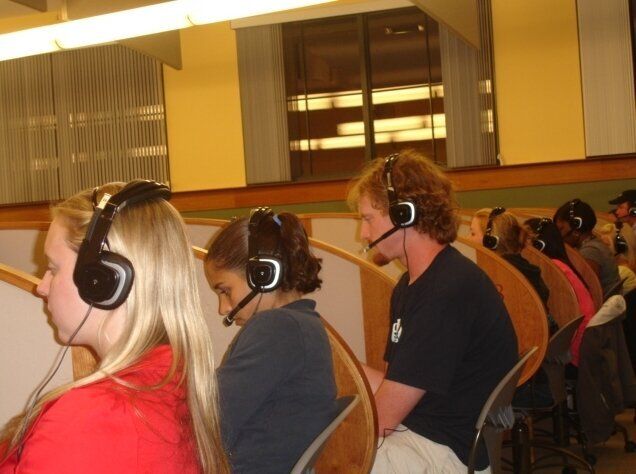
Ever wonder where these polls that are quoted all the time by news organizations get their info? As chance would have it, I don't live that far from one of the leading Polling Institutes so I self deployed on a mission to find out what goes on, how they get their numbers and more importantly, what does it mean?
My first contact was with Douglas Schwartz, PhD, director of the Quinnipiac University Poll, he is responsible for the poll's methodology and all aspects of the survey process, otherwise known as the chief polling guru, directing each project from conception through analysis.
In a phone interview he explained the polling process of random sampling of the population by computer generated phone calls based on area code and exchange so they don't know who they are calling or speaking to when the call is answered. This allows for sampling the unlisted 25%-33% phones. So that explains how they get your digits when you pay to keep your phone unlisted. Because it's random, they also get a good portion of fax machines, government offices, bad numbers and hang ups. To keep the survey from being skewed, they ask for the adult who is next going to be celebrating their birthday, since generally 70% of the phones are answered by a woman, that's if the person hasn't hung up already.
If you are part of the 15% and growing population that only has a cell phone as your primary contact, you will not receive that call. Currently, Federal law prohibits polling calls to cells. Quinnipiac has an auto dialer that blocks the cell exchanges. So for the majority of young adults who operate by cell, their opinions are not polled. Dr. Schwartz noted that Pew Research found that including those using a strictly a cell phone, the results would not change much. He stated the 2004 National Election exit polls found of those interviewed, 7% of the population had a cell only and voted slightly more for Kerry then Bush. It will be really interesting what this year's results will show.
So, who designs the poll questions? Between Dr. Schwartz and the Polling Institutes' Analysts, they have a standard list of questions and then they come up with current news topics or regional and state specific questions. They are fortunate to have Analysts that are former journalists, going over each question collectively to make sure each question is fair balanced, neutral and the wording is clear.
The Institute is 100% funded by Quinnipiac University and the workforce is a 50-50 blend of Quinnipiac students, working adults as a second job or retirees, all work evenings and weekends. Non-students work throughout the year. A majority of the students are majoring in Political Science, Marketing, PR or other related fields. The students don't work during school breaks when the dorms are closed, some are on work study and some are not. Some have worked each year they are attending school, for others this is their first month working as opinion gatherers. Before they get on the phones speaking to you, they have gone through a three hour training class and additional practice run-throughs and are then closely monitored by supervisors.
Quinnipiac usually doesn't team up to get "assignments" by news organizations but on occasion they will. They do not accept assignments from political parties or candidates. Often they may have several polls running at the same time. Currently they are working on multi-state National Election Polls until November 4th and then they will move onto State and Local polls for Mayoral and State Senate races in 2009 and 2010. Other times they create their own surveys .
One evening this week led me to the heart of the operation, The Quinnipiac Polling Institute, located on a hillside overlooking Hamden, CT's Sleeping Giant State Park. In a new building they have almost 160 phones and operators working 7 days a week taking the pulse of those who are willing to answer about 8 minutes of scripted questions.
So while we may all want to know, "Is Sarah Palin considered a lipstick smacking pit bull?" There maybe a question posed as "Will the VP choice of Sarah Palin make you want to vote for republican Nominee John McCain more, less or it makes no difference?"
Arriving a few minutes early I meet up with Dorothy Donarum, manager of interviewer operations whom gave me a tour of the brand new building while explaining what they would be doing that evening. As workers entered the building, their seating assignments are posted, I casually asked a retiree if she had a favorite chair, laughing, she said no. I then spotted Julie Sholz, age 18, a Quinnipiac freshman, in her second week working as a pollster looking for her booth assignment. Lucky Julie, I decided I would shadow her.
Julie's cubicle is part of a small cluster and as she sat down and logged into the system others nearby also began work. The first call made went to a fax machine, then continuing she went thru call after call, most without success to get a complete interview, nearby others where talking to the residents of the state they were calling and the noise level of the large room began to get louder as time and connections continued.
In my own survey of the 8 people in the pod, there were 7 students; 6 female, 1 male and 1 female adult (Mom of a former pollster) whose experience ranged from their first night to 4 years. Amongst them there are 6 registered voters, 1 who plans to register before the election and Paola, an international Student from Mexico who is also 1 of 2 translators of the poll questions and follows up with those who speak Spanish only. In a 50-50 spilt leaning towards Obama or still undecided, with 1 refusing to state their preference.
The night continued and while waiting for the next call to come in there was quiet banter about a teacher they had this semester but for the most part they stared at the screen as it went through the motions of placing calls, their introduction and then... either the person hung up or they continued with the interview. At a certain point the states that they were interviewing changed over to another state in another time zone and they continued making calls. Most operators will make at least 250 calls each over a 4 hour period, that's a lot of talking even for college students! They all assured me they don't have nightmares of repeatedly asking the same questions in their sleep. In each state they try to capture at least 1,000 surveys and the raw data is analyzed with a report released within a few days of the survey completion. For the survey I observed, it will be released to the public on Tuesday. Quinnipiac Polling Institute will release the data at a press conference in Washington D.C at 10 AM. They will also be posting it on the website that morning. And here are the results.
---
Image: The Quinnipiac offices; Mary Ann West
